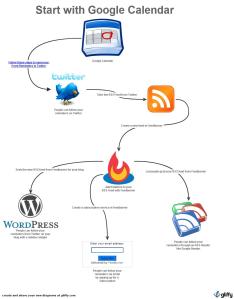This blog post is inspired by a post from Amanda Sollman, "How integrated is your communication?" and all the wonderful agriculturalists that are attending the first Ag Chat Foundation Conference in Chicago. I hope this post can help people that are spreading the good word about agriculture as well as administrators and teachers at schools spreading the wonderful things that they are doing for education.
The main question that Sollman asks in her post is "...do I have information that could be easily transferred across communication mediums?" I have tried to make my communication at school as broad as possible for all members of the community, staff, students, parents and all the supporters of the school. Not only do I want to reach the widest audience possible, I would also like to keep the communication steps as simple as possible. This is the information that I would like to share and if you have any suggestions on how I could improve these steps please leave a comment to help others.
The first step is to get the communication process started. For our school that can come from two different sources, a blog post or from our school calendar.
The blog post route is shorter so lets start with the calendar: (Calendars are great for school events but it could also be great for a person or foundation; schedule talks, public appearances, #AgChat on twitter, conferences, barn tours, etc.)

- Put all events on Google Calendar
- Google Calendar sends out an event reminder that tweets out the reminder on Twitter (see all the steps here)
- Take the RSS feed from Twitter and make a feed in Feedburner. (You could just use the RSS, but Feedburner gives you extra cool features)
- Put the RSS feed from Feedburner on your website to have a dynamically changing page. (This would be a sidebar widget with all of your tweets)
- Last put a subscription link from Feedburner (This will allow people to get an email with your tweeted reminders.)
If your are starting with a blog post start with step 3 and we have a new step 4. So the steps will look like this:
- Take the RSS feed from your blog and make a feed in Feedburner (You could just use the RSS, but Feedburner gives you extra cool features)
- In Feedburner use the Publicize tab to add Socialize to your feed. (This will allow your blog to automatically tweet the link for the new post.)
- Last put a subscription link from Feedburner so people can get your post in email form. (This will allow people to get an email with your new blog posts.)
This might not be new information to some, so lets take it a step further and add Facebook into the mix. There are two types of ways to get your message out on Facebook. A personal page or a fan page. We use a fan page at school so we will use that.
- Take your RSS feed from Feedburner (If you are sending new blog post tweets from Feedburner you will only need your Twitter feed) and use a service such as TwitterFeed to send your tweets to Facebook.
- A word of caution...if your are sending your Facebook posts to Twitter you will cause an infinite loop if you set up Twitterfeed also. I would recommend one or the other. The nice thing about TwitterFeed is you can still use Facebook and all of your Tweets including new blog posts will be automatically added to Facebook.
Last lets add our videos that we upload to Youtube into our communications. Youtube is great about allowing you to get your videos out to your audience. The process below I believe will give you the most effective communication.
- Upload your video and then embed it into your blog. (if using the steps above for a blog post, this will then allow your video to go out to your public on your website, an RSS feed, Twitter, Email and Facebook all with one post)
Video Extra: We are using a very simple to use web tool called JayCut that has some decent editing features to take your videos to the next level. It even has an export to Youtube feature allowing you to send your new masterpiece straight to Youtube. Also, Youtube now has some simple editing features on there website as well.


